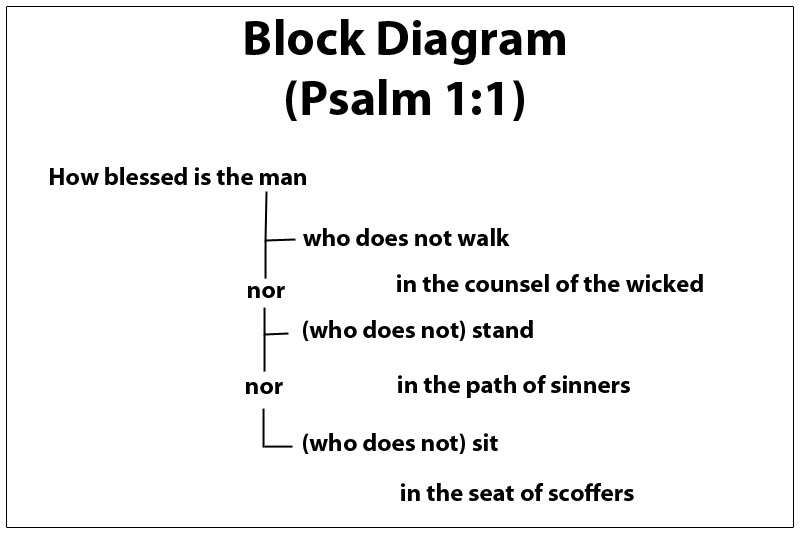The Exposition of Biblical Poetry: I have been preaching weekly sermons for twenty-seven years or so. I have mainly preached sermons from the books of the New Testament. I have only preached through a couple of books from the Old Testament and several one off messages from different passage of the Old Testament. Because I majored in the Greek language while at seminary, I decided I would preach mainly from the New Testament.
However, over the last few years I have come to appreciate the Psalms in a new light and I decided I would preach through the Psalms. I spent many months studying the exposition of biblical poetry before I started preaching the Psalms.

The Exposition of Biblical Poetry
When I wrote sermons and sermon outlines for the books of the New Testament, I had formulated a paradigm that I put in place that guided me through the whole sermon process.
However, this paradigm was somewhat inadequate for the preaching of the Psalms because of the different literature of the Psalms and the New Testament. The Psalms being biblical poetry were different to the prose literature of the New Testament.
In light of this predicament, I decided to purchase several books that focused entirely on preaching the Psalms, the exposition of biblical poetry, the expository preaching of the Psalms and exegetical commentaries of the Psalms in order to look at how I could adjust my paradigm so that it would guide me in the preaching of the Psalms.
In this article I want to look at Leland Ryken’s five indispensable steps to a good exposition of biblical poetry because I found this material to be most informative and helpful.
I had read several great books about the exposition of biblical poetry. However, Leland Ryken material was most helpful in adjusting my paradigm as I studied his five insightful steps for the exposition of biblical poetry.
1. Genre and Implied Situation
The first step involves identifying the genre and the implied situation. Unless you identify the genre type and the implied situation, you will only have a very hazy picture of the text and the interpretation of the text.
The genres of the Psalms fall into seven categories: wisdom psalms, lament psalms, royal psalms, enthronement psalms, pilgrimage psalms, thanksgiving psalms and imprecatory psalms. You will find that commentators may vary with the terms of these types of categories.
The implied situation is very helpful in understanding what is going on in the psalms. It is useful to know that the speaker in Psalm 10 is in the middle of a crisis in which his enemies have slandered him. Psalms 42-43 will make a lot more sense if you realize that the speaker is living in exile and is therefore prevented from worshiping God in the temple in Jerusalem. Psalm 121 presupposes a pilgrimage to Jerusalem (Leland Ryken).
2. The Intellectual Core
Once you have put the psalm into its literary family and made explicit any situation that is implied in the psalm, the next logical step is to summarize what the psalm is about.
This is where you work the topic and theme of the psalm. What is the psalm about (topic) and what is the psalm saying about the topic (theme).
3. Structure and Unity
With the genre and main idea and theme identified, the next step is to lay out the unity and structure of the Psalm.
I find the best way to clarify unity and structure is to block diagram the Psalm or diagram the Psalm in Hebrew. I majored in Greek at seminary and therefore block diagram the Psalms in English.
The aim here is to give an overview of the whole Psalm in order to provide clear pathways through the Psalm.

4. Poetic Texture
The structure of the Psalm is like the two-by-threes that hold up the wall. However, the wall is covered by panels. The details in a Psalm—the actual words and figures of speech—are like the panels. This is called poetic texture.
Poetic texture consists of words, images, metaphors, similes, apostrophes, personifications, hyperboles and any other figures of speech.
These figures of speech are what actually communicate the meanings of the Psalms. You will need to spend time exploring the meanings of these figures of speech because they are rich in meaning in Hebrew poetry.
5. Artistry
To understand the Psalms, you will need to put the above four steps into practice. Nevertheless, you will also need to familiarize yourself with the verse form of parallelism.
Some Concluding Comments:
To write sermons from the Psalms, I simply follow the four steps mentioned by Leland Rykens keeping in mind the fifth step of the verse form of parallelism.
Below are the sermon outlines that I developed for preaching Psalm 1 and Psalm 23.
True Happiness is Found in the Lord (Psalm 1:1-6)
- The Person God Blesses (1:1-3)
- We see his passion (1:1a)
- We see his path (1:1b)
- We see his pleasure (1:2)
- We see his prosperity (1:3)
- The Person God Judges (1:4-5)
- We see his path (1:4)
- We see his punishment (1:5)
- The Person God Approves (1:6)
- We see the righteous prosper (1:6a)
- We see the wicked perish (1:6b)
Two Pictures of God’s Goodness and Care (Psalm 23:1-6)
- The Picture of the Shepherd (23:1-4)
- He meets our needs (23:1b)
- He gives us rest (23:2)
- He gives us life (23:3a)
- He guides us in life (23:3b)
- He keeps us safe (23:4)
- The Picture of the Generous Host (23:5-6)
- He provides for the present (23:5)
- He provides for the future (23:6)
The sermon outlines from Psalm 1 and Psalm 23 were provided by Rev. D. Blackburn BA GDM
Some Resources for the Exposition of Biblical Poetry
Words of Delight: A Literary Introduction to the Bible by Leland Ryken
Holman Old Testament Commentary of the Psalms (Volume 1 & Volume 2) by Steven J. Lawson
An Expositional Commentary of the Psalms (Volume 1, Volume 2 and Volume 3) by James Montgomery Boice
A Commentary of the Psalms (Volume 1, Volume 2 and Volume 3) by Allen P. Ross
The NIV Application Commentary of the Psalms (Volume 1) by Gerald H. Wilson
The Dictionary of Biblical Imagery by Leland Ryken